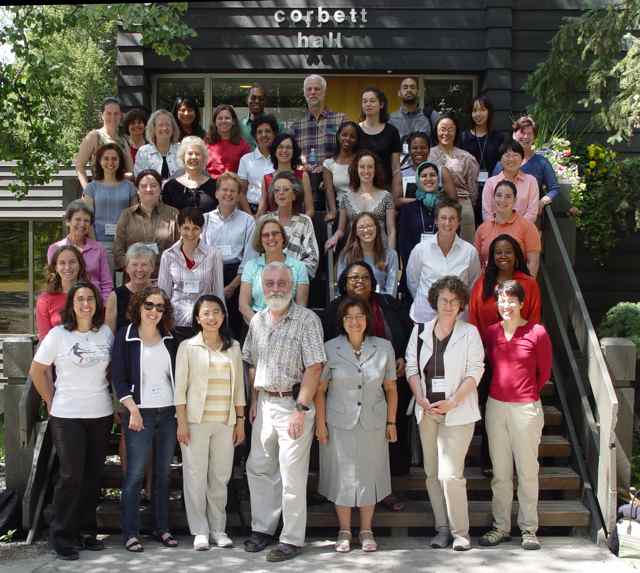


 |  |  | Preface |
 |
This book is a distillation of the presentations and discussions of a workshop entitled Mentoring for Engineering Academia II held at the Banff International Research Station (BIRS) for Mathematical Innovation and Discovery in July 2008. The title reflects the origins of the workshop in an earlier workshop which took place in June 2004 at Stanford University on the subject of mentoring for academic careers in engineering. For two days (20-22 June) the original workshop provided a forum on the needs, goals, methods, and best practices for mentoring engineering students interested in an academic career, young faculty beginning such a career, and recently tenured faculty. The emphasis was on mentoring members of underrepresented groups in academic engineering, especially women. The workshop was jointly supported by a Presidential Award for Excellence in Science, Mathematics, and Engineering Mentoring (PAESMEM) through the National Science Foundation, and by the School of Engineering at Stanford University. Workshop funding was largely devoted to providing local housing and sustenance for workshop attendees. Participation was by invitation and application. There were no registration or other fees. Participants included experienced mentors along with recent graduates and students who were considering, had decided upon, or had begun academic careers. Faculty in leadership positions were invited along with those emphasizing research and teaching. The workshop consisted of invited presentations, proposed presentations by participants that were accepted by the Organizing Committee, panel discussions, and informal discussions. There was an admitted bias towards EE/CS because of the constitution of the Organizing/Program Committee and the initial group of people involved, but all engineering disciplines were welcomed along with other related disciplines where there was interest.
The PAESMEM workshop had two primary goals. The obvious one was to provide an opportunity for mentors, protégés or mentees, and mentoring facilitators to educate each other and have fun doing so. The second goal was a deliverable: to produce proceedings of the workshop, including summaries of the talks and discussions. The slides of the talks and the proceedings were made available at the workshop web site http://paesmem.stanford.edu/ and several hundred copies of the proceedings were printed and distributed among the participants and others who requested them.
 |
In July 2005 I was attending a workshop on Multimedia and Mathematics at the Banff International Research Station (BIRS) in Alberta, Canada, which had been organized by Rabab Ward of the University of British Columbia and me. We were encouraged to consider future proposals for BIRS workshops of interest to mathematically inclined engineers, and strong interest was expressed by the BIRS management in our suggestion of a follow-up workshop on mentoring for engineering academia. The group of co-organizers was expanded to include Professors Eve Riskin of the University of Washington and Sheila Hemami of Cornell University. A formal proposal was submitted, and a five-day workshop was awarded for 22-27 July 2007. Following two years of preparations, the workshop was held, and these proceedings provide a record of what the experience. The BIRS workshop shared the goals of the original PAESMEM workshop: to provide a productive and enjoyable environment for an intense consideration of mentoring for academic careers in engineering and to write up and distribute a record of the of the workshop in order to share results with a wider audience.
Why workshops? Workshops bring together a much more varied and diverse group than one is likely to meet under ordinary conditions. Bringing undergraduate and graduate students together with faculty of all levels, from assistant professors to presidents of colleges and professional organizations, can be an incredible learning experience in both directions, from practiced mentors to beginning students, and from students and junior faculty to their senior colleagues. The variety of ideas and experience brought to such workshops stimulates fascinating discussions of traditional and unexpected topics, along with a rich collection of personal stories that exhibit the richness of academic careers. The percentages of demographic groups can be purposefully altered to let traditional majorities and minorities change roles and experience the resulting dynamics in presentations and discussions. Several days of intense interactions with lots of time for chats, hikes, strolls, and reflection can stimulate and motivate participants, as well as provide new professional connections and an interdisciplinary network among mentors, protégés, colleagues, and friends. Set all of this in one of the most beautiful national parks in the world, and it results in a workshop that is productive and more fun than many vacations.
Special thanks to the Banff International Research Center for supporting this workshop. In particular, we would like to thank the Scientific Director Professor Nassif Ghoussoub, the Facilitator Andrea Lundquist, and the Station Manager Brenda Shakotko for all of their help in organizing the workshop and its logistics. Thanks to the U.S. National Science Foundation for the travel support. Thanks to the participants who contributed photos of the sessions and activities: Pam Cosman, Misty Davies, Min Wu, Maria Klawe, Christine McKay, Luciana Ferrer, Jia Li, Tracey Ho, and Veronica Wadey. Thanks to the participants who provided major editing assistance to help polish the many drafts, especially Michelle Effros, Michele Marincovich, Patti Ordoñez, and Luciana Ferrer. Thanks to Kelly Yilmaz for her administrative assistance.
|
Robert M. Gray |
| Co-organizer and Editor |


 |  |  | Preface |